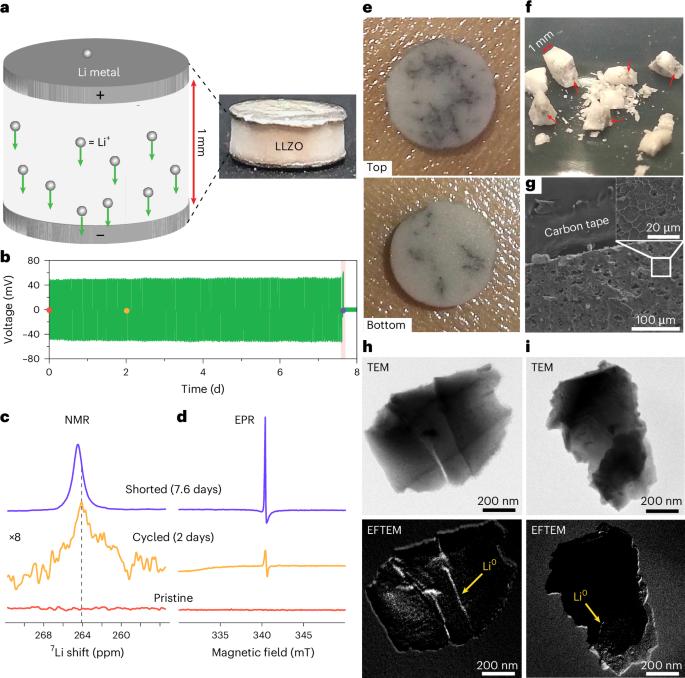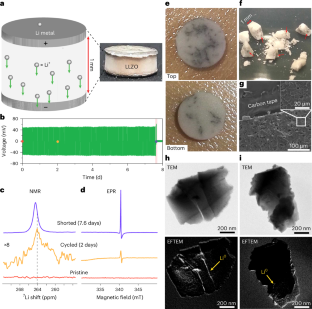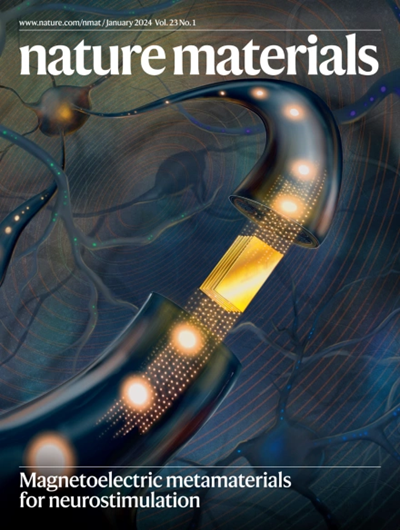固态电池中由于镀锂和电解液还原而形成的枝晶
IF 38.5
1区 材料科学
Q1 CHEMISTRY, PHYSICAL
引用次数: 0
摘要
全固态电池提供高能量密度和环保的能量存储,但由于枝晶的形成,特别是锂金属阳极,面临商业障碍。在这里,我们报告了Li/Li7La3Zr2O12/Li电池中的枝晶形成通过两种不同的机制发生,使用非侵入性固态核磁共振和磁共振成像。示踪交换核磁共振显示,电极-电解质界面不均匀镀Li, Li7La3Zr2O12晶界处局部Li+还原。原位磁共振成像显示,不均匀的Li镀层快速形成枝晶,随后Li+还原缓慢成核,中间有一段生长停滞期。非晶枝晶的形成和随后的结晶,固体电解质的缺陷化学和电池的操作条件在形成这两种机制之间复杂的相互作用中起着关键作用。总的来说,这项工作加深了我们对固态锂电池中枝晶形成的理解,并提供了可能对减轻枝晶相关挑战有价值的全面见解。本文章由计算机程序翻译,如有差异,请以英文原文为准。


Dendrite formation in solid-state batteries arising from lithium plating and electrolyte reduction
All-solid-state batteries offer high-energy-density and eco-friendly energy storage but face commercial hurdles due to dendrite formation, especially with lithium metal anodes. Here we report that dendrite formation in Li/Li7La3Zr2O12/Li batteries occurs via two distinct mechanisms, using non-invasive solid-state nuclear magnetic resonance and magnetic resonance imaging. Tracer-exchange nuclear magnetic resonance shows non-uniform Li plating at electrode–electrolyte interfaces and local Li+ reduction at Li7La3Zr2O12 grain boundaries. In situ magnetic resonance imaging reveals rapid dendrite formation via non-uniform Li plating, followed by sluggish bulk dendrite nucleation from Li+ reduction, with an intervening period of stalled growth. Formation of amorphous dendrites and subsequent crystallization, the defect chemistry of solid electrolytes and battery operating conditions play a critical role in shaping the complex interplay between the two mechanisms. Overall, this work deepens our understanding of dendrite formation in solid-state Li batteries and provides comprehensive insight that might be valuable for mitigating dendrite-related challenges. NMR spectroscopy and imaging show that dendrites in a solid-state Li battery are formed from Li plating on the electrode and Li+ reduction at solid electrolyte grain boundaries, with an interlapped stalled growth period.
求助全文
通过发布文献求助,成功后即可免费获取论文全文。
去求助
来源期刊

Nature Materials
工程技术-材料科学:综合
CiteScore
62.20
自引率
0.70%
发文量
221
审稿时长
3.2 months
期刊介绍:
Nature Materials is a monthly multi-disciplinary journal aimed at bringing together cutting-edge research across the entire spectrum of materials science and engineering. It covers all applied and fundamental aspects of the synthesis/processing, structure/composition, properties, and performance of materials. The journal recognizes that materials research has an increasing impact on classical disciplines such as physics, chemistry, and biology.
Additionally, Nature Materials provides a forum for the development of a common identity among materials scientists and encourages interdisciplinary collaboration. It takes an integrated and balanced approach to all areas of materials research, fostering the exchange of ideas between scientists involved in different disciplines.
Nature Materials is an invaluable resource for scientists in academia and industry who are active in discovering and developing materials and materials-related concepts. It offers engaging and informative papers of exceptional significance and quality, with the aim of influencing the development of society in the future.
 求助内容:
求助内容: 应助结果提醒方式:
应助结果提醒方式:


